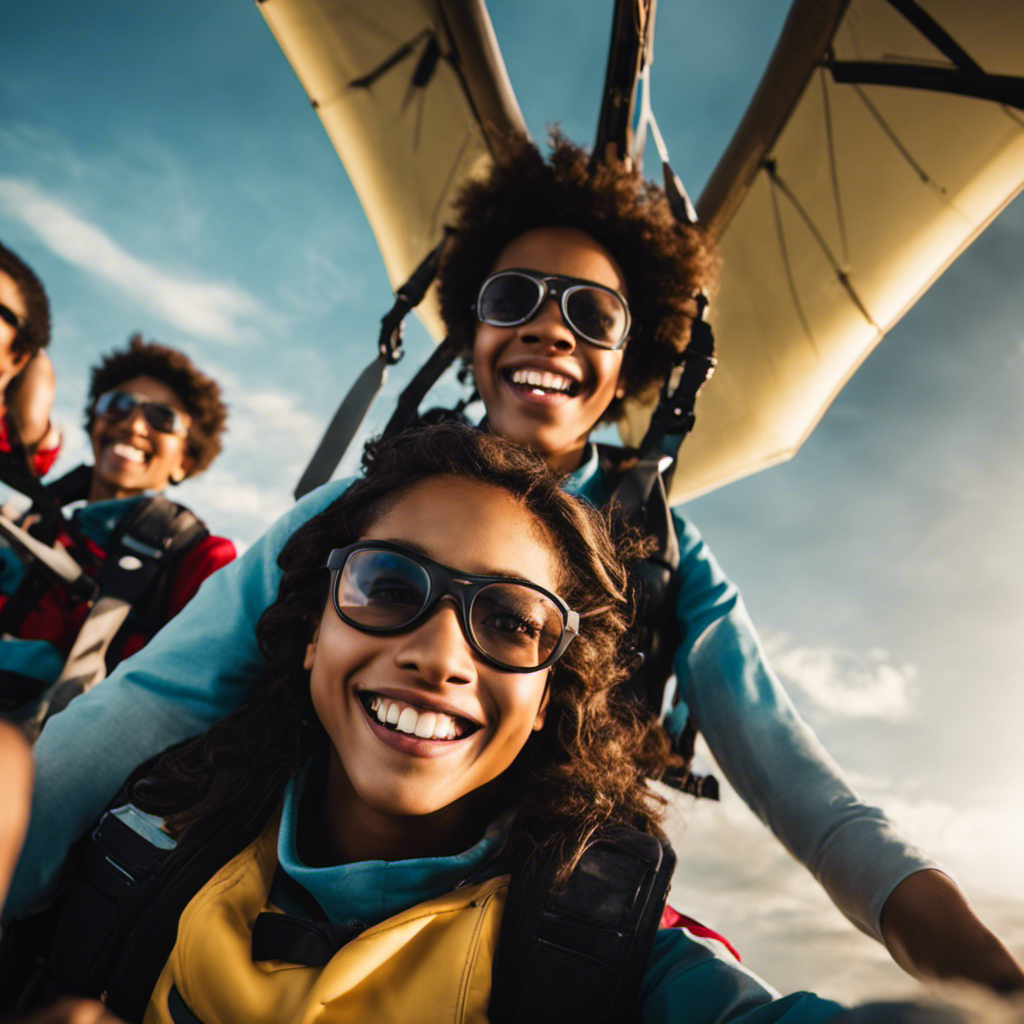As a glider pilot myself, I can attest to the incredible benefits that gliding offers to young people.
Gliding is not just a recreational activity; it has the power to inspire and motivate, foster teamwork and collaboration, build confidence and resilience, and enhance problem-solving and decision-making abilities.
In this article, we will explore the role of gliding in youth development, the importance of diversity and inclusion in gliding programs, and the exciting career opportunities that await young gliders in the industry.
Get ready to soar to new heights with gliding and youth engagement!
Key Takeaways
- Gliding enhances personal development, creativity, independence, self-confidence, and self-reliance in youth.
- Gliding promotes teamwork, collaboration, effective communication, problem-solving skills, and leadership abilities.
- Gliding offers exciting career opportunities in the gliding industry, such as pilot positions, instructor or coach, maintenance technician, air traffic controller, and aerospace engineer.
- Gliding improves physical fitness, cardiovascular health, muscle strength, stress relief, and overall well-being in youth, while also fostering environmental awareness and conservation efforts.
The Benefits of Gliding for Youth Engagement
The benefits of gliding for youth engagement are numerous and can greatly enhance their personal development. Gliding is not only a thrilling sport but also a gateway to inspiring creativity and fostering independence in young individuals. When young people are exposed to the world of gliding, they are encouraged to think outside the box and explore their own unique ideas. Gliding requires strategic thinking, problem-solving skills, and the ability to adapt to changing situations, all of which contribute to the development of their creativity.
Furthermore, gliding provides an opportunity for youth to foster independence. As they take control of the glider and navigate through the skies, they learn to trust their own judgment and make decisions on their own. This sense of independence helps them develop self-confidence and self-reliance, which are crucial skills for their future endeavors. Gliding also teaches them the importance of responsibility and discipline, as they need to follow safety procedures and adhere to rules and regulations.
How Gliding Can Inspire and Motivate Young People
Get ready to be inspired and motivated by how gliding can spark your enthusiasm and drive as a young person.
Gliding is not just a recreational activity; it is a gateway to inspiring creativity and promoting self-discovery.
When I first took to the skies in a glider, I was amazed at the sense of freedom and exhilaration that washed over me. It was as if I had found a new passion that would fuel my creativity and push me to explore the depths of my potential.
Gliding allows young people to break free from the confines of the ground and soar through the clouds. The experience of being up in the air, with nothing but the wind guiding you, encourages a sense of adventure and curiosity. It opens up a whole new world of possibilities and challenges, pushing you to think outside the box and find innovative solutions to problems.
Furthermore, gliding promotes self-discovery. As you navigate the skies, you learn to trust yourself and your abilities. You gain confidence in your decision-making skills and learn to adapt to changing conditions. Gliding teaches you resilience and perseverance, qualities that are essential for success in any endeavor.
In conclusion, gliding is not just about flying; it is about inspiring creativity and promoting self-discovery. It ignites a fire within young people, driving them to think differently and explore their potential.
Exploring the Role of Gliding in Youth Development
Exploring how gliding can play a significant role in developing young people is an exciting endeavor. Gliding is not just a thrilling sport; it also offers numerous benefits for personal development. As a form of recreation and leisure, gliding allows young individuals to challenge themselves, build confidence, and cultivate important life skills.
Here is a table showcasing the role of gliding in personal development:
| Personal Development Areas | Role of Gliding |
|---|---|
| Self-Confidence | Gliding pushes young people out of their comfort zone and helps them overcome fears, boosting self-confidence. |
| Resilience | Handling unpredictable weather conditions and learning from mistakes during gliding teaches resilience and adaptability. |
| Decision Making | Piloting a glider requires quick decision-making skills, enhancing critical thinking abilities. |
| Goal Setting | Gliding encourages young individuals to set goals, work towards achieving them, and celebrate their accomplishments. |
Engaging in gliding not only provides an adrenaline rush but also fosters personal growth. It allows young people to develop essential life skills that will benefit them in various aspects of their lives. Gliding provides an opportunity to step away from the pressures of everyday life and immerse oneself in a thrilling recreational activity that promotes personal development. With these valuable skills in tow, young gliders are well-prepared for the next section: fostering teamwork and collaboration through gliding.
Fostering Teamwork and Collaboration Through Gliding
Fostering teamwork and collaboration through gliding is an effective way for young individuals to develop strong interpersonal skills. Gliding not only provides an exhilarating experience but also offers numerous opportunities for team building and collaboration. Here are some reasons why gliding is a fantastic activity for developing these skills:
-
Communication: Gliding requires effective communication between the pilot and the co-pilot. Clear and concise communication is crucial to ensure a safe and successful flight.
-
Trust: Gliding involves trusting your co-pilot and the team. The pilot relies on the co-pilot for navigation and decision-making, fostering trust and reliance on one another.
-
Problem-solving: Gliding presents various challenges that require quick thinking and problem-solving skills. Pilots and co-pilots must work together to overcome obstacles and make split-second decisions.
-
Leadership: Gliding allows individuals to take turns in the role of pilot and co-pilot, encouraging the development of leadership skills. Each team member gets a chance to lead and guide the flight, enhancing their ability to lead effectively.
By participating in gliding, young individuals can develop these essential team building and collaboration skills in a thrilling and practical way.
Gliding not only promotes personal growth and self-confidence but also prepares young individuals for success in both personal and professional settings.
Building Confidence and Resilience in Young Gliders
Building confidence and resilience in young gliders is essential for my personal and professional development. As a young glider myself, I understand the importance of building self-esteem and resilience in this exhilarating sport. Gliding challenges me both physically and mentally, and it is through overcoming these challenges that I have grown as an individual.
Building self-esteem is a crucial aspect of gliding. When I first started, I was filled with self-doubt and fear. However, with each successful flight, my confidence grew. The feeling of soaring through the sky, relying solely on my skills and judgment, has boosted my self-esteem in ways I never imagined.
In addition to self-esteem, gliding has also taught me the importance of building resilience. Gliding can be unpredictable, with changing weather conditions and unexpected challenges. Learning to adapt and bounce back from setbacks has been instrumental in my growth as a glider. It has taught me to remain determined and persevere in the face of adversity.
The skills I have developed through building self-esteem and resilience in gliding have not only benefited me in the sport but also in other areas of my life. I have become more confident in taking on new challenges and more resilient in overcoming obstacles. These qualities will undoubtedly contribute to my personal and professional success in the future.
The Impact of Gliding on Physical Fitness and Well-being in Youth
Take a moment to consider how gliding can positively impact your physical fitness and overall well-being.
As a glider myself, I’ve experienced firsthand the incredible benefits that this sport can bring to both my physical development and mental health. Here are a few ways that gliding can have a profound impact on your well-being:
-
Improved cardiovascular health: Gliding requires a significant amount of physical exertion, especially during takeoff and landing. This helps to strengthen your heart and lungs, improving your overall cardiovascular fitness.
-
Increased muscle strength and tone: The act of controlling the glider’s movements requires the use of various muscle groups, including your arms, back, and core. Over time, this can lead to increased muscle strength and tone, helping to improve your overall physical performance.
-
Stress relief: Gliding allows you to escape the hustle and bustle of everyday life and immerse yourself in the beauty of nature. This can have a calming effect on your mind, reducing stress and promoting relaxation.
-
Boosted confidence and self-esteem: Mastering the art of gliding requires dedication and perseverance. As you achieve new milestones and overcome challenges, your confidence and self-esteem will soar, leading to a positive impact on your mental well-being.
In conclusion, gliding is not just a thrilling sport but also a powerful tool for physical development and mental health. Whether you’re looking to improve your fitness or find an escape from the stresses of life, gliding can offer a transformative experience.
Harnessing the Power of Gliding to Teach Discipline and Focus
When harnessed effectively, gliding can instill discipline and focus in individuals, enhancing their overall personal growth and development. Gliding requires a high level of concentration, as pilots must constantly monitor their instruments, make quick decisions, and adjust their position in the air. This teaches discipline by instilling the importance of following procedures and staying focused on the task at hand.
In my experience, gliding has taught me valuable lessons in discipline and focus. The structured nature of gliding operations, with pre-flight checks, specific procedures, and clear objectives, has taught me the importance of following instructions and maintaining a high level of concentration throughout the flight. This level of discipline transfers into other areas of my life, helping me stay focused on my goals and tasks.
To illustrate the impact of gliding on discipline and focus, consider the following table:
| Gliding Activity | Discipline | Focus |
|---|---|---|
| Pre-flight checks | ✔️ | ✔️ |
| Following procedures | ✔️ | ✔️ |
| Monitoring instruments | ✔️ | ✔️ |
| Making quick decisions | ✔️ | ✔️ |
As you can see, gliding activities require discipline and focus in multiple aspects. By teaching individuals to follow procedures, make quick decisions, and stay focused on their instruments, gliding effectively instills discipline and enhances their ability to concentrate.
Overall, gliding is a powerful tool for teaching discipline and instilling focus in individuals. The structured nature of gliding operations and the demands of flying help develop important skills that can be applied to various areas of life. Whether it’s following procedures, making quick decisions, or staying focused on the task at hand, gliding enhances personal growth and development by teaching individuals the value of discipline and focus.
Encouraging Environmental Awareness and Conservation Through Gliding
As we explore the various ways that gliding can engage and benefit young people, it’s important to highlight the positive impact it can have on environmental awareness and conservation. Gliding offers a unique opportunity to educate and inspire young individuals about the importance of protecting our planet.
Here are a few ways in which gliding can encourage environmental education and sustainable practices:
-
Hands-on Learning: Gliding allows young people to experience nature firsthand and witness the beauty of the environment from a unique perspective, fostering a deeper connection and appreciation for the natural world.
-
Energy Efficiency: Gliders rely on renewable energy sources such as wind and thermals, showcasing the potential of sustainable practices and highlighting the importance of reducing our carbon footprint.
-
Conservation Efforts: Glider clubs often engage in environmental initiatives such as tree planting and habitat restoration, giving young gliders the opportunity to actively participate in conservation efforts and make a positive impact.
-
Education Programs: Many gliding clubs offer educational programs that focus on environmental conservation, teaching young people about the importance of protecting ecosystems and wildlife.
By incorporating environmental education and sustainable practices into the world of gliding, we can empower young individuals to become responsible stewards of our planet.
Now, let’s explore how gliding can help youth overcome challenges and adversity.
Overcoming Challenges and Adversity in Youth Gliding
Facing challenges and adversity, young gliders can develop resilience and perseverance, enabling them to grow both personally and professionally. Overcoming obstacles is an integral part of the gliding experience, and it teaches valuable life lessons that can be applied in various aspects of life. Resilience training is essential for young gliders as it equips them with the mindset and skills needed to overcome adversity and achieve their goals.
In the face of challenges, gliders learn to adapt and find solutions. This ability to think on their feet and make quick decisions is crucial for success in gliding and can be transferred to other areas of life. Additionally, gliding requires discipline and dedication, as it involves rigorous training and a commitment to continuous improvement. These qualities are essential for achieving success in any field.
To illustrate the importance of resilience training in gliding, let’s take a look at the following table:
| Challenges in Gliding | Benefits of Resilience Training |
|---|---|
| Unpredictable weather conditions | Improved problem-solving skills |
| Equipment malfunctions | Increased adaptability |
| Competitive pressure | Enhanced mental toughness |
Cultivating Leadership Skills Through Gliding for Young People
Cultivating leadership skills through gliding helps young people develop qualities such as teamwork, communication, and decision-making. As a glider pilot myself, I have witnessed firsthand the transformative power of this sport in fostering personal growth and leadership development.
Here are four ways that gliding nurtures these essential skills:
-
Teamwork: Gliding requires coordinated efforts between the pilot and ground crew. Working together seamlessly is crucial for a successful flight. Through this collaboration, young people learn the importance of effective teamwork and how to support and rely on one another.
-
Communication: Gliding demands clear and concise communication between the pilot and crew members. From pre-flight briefings to in-flight instructions, effective communication is essential for a safe and efficient flight. Young people learn how to articulate their thoughts, listen actively, and convey information accurately.
-
Decision-making: Gliding presents various challenges and decisions that need to be made quickly and effectively. Young pilots learn to assess situations, analyze risks, and make informed decisions under pressure. These skills translate into other aspects of life, enabling young people to make sound choices and take calculated risks.
-
Responsibility: Gliding instills a sense of responsibility in young pilots. They are entrusted with the safety of themselves and their crew members. This fosters a strong sense of accountability, reliability, and commitment to the task at hand.
Enhancing Problem-Solving and Decision-Making Abilities Through Gliding
When it comes to gliding, the benefits extend beyond just the thrilling experience of soaring through the sky.
Not only does gliding provide skill development in areas such as hand-eye coordination and spatial awareness, but it also offers unique opportunities for cognitive growth.
Through the challenges and decision-making required during a gliding experience, individuals can enhance their problem-solving abilities and develop a sharper sense of decision-making.
Skill Development Benefits
You can gain valuable skill development benefits through gliding and youth engagement. Gliding not only provides a thrilling experience but also offers opportunities for personal growth and skill enhancement.
Here are some ways in which gliding can contribute to skill development and personal growth:
-
Problem-solving: Gliding requires quick thinking and decision-making, as you navigate through different weather conditions and terrain.
-
Communication: Working in a team during gliding activities helps improve communication skills, as you coordinate with fellow gliders and instructors.
-
Resilience: Gliding teaches you to adapt to unpredictable situations, building resilience and the ability to remain calm under pressure.
-
Leadership: Taking charge of a gliding mission or guiding others during training sessions can develop leadership skills.
Engaging in gliding activities not only provides an adrenaline rush but also fosters important skills that can benefit you in various aspects of life.
Cognitive Growth Opportunities
Developing cognitive skills can greatly enhance your mental abilities and contribute to personal growth in various areas of your life. When it comes to personal growth, cognitive development plays a crucial role in shaping our thinking, problem-solving, and decision-making abilities.
It allows us to acquire knowledge, process information, and improve our overall mental functioning. By engaging in activities that challenge our cognitive abilities, such as puzzles, reading, or learning a new skill, we can strengthen our cognitive skills and promote personal growth.
These activities stimulate our brain, improve our memory, and enhance our creativity, enabling us to adapt to new situations and excel in various aspects of life. So, if you’re looking to expand your horizons and achieve personal growth, don’t underestimate the power of cognitive development.
Start challenging your mind today and unlock your full potential.
Promoting Diversity and Inclusion in Youth Gliding Programs
If you want to promote diversity and inclusion in youth gliding programs, it’s important to create an inclusive and welcoming environment for all participants. As a gliding instructor, I believe in the power of youth empowerment and promoting inclusivity in our programs.
Here are some key strategies to achieve this:
-
Foster a sense of belonging: Encourage participants to express themselves and actively listen to their ideas and experiences. Make sure they feel valued and included in all aspects of the program.
-
Embrace diversity: Celebrate the unique backgrounds, cultures, and perspectives of each participant. Create opportunities for them to learn from one another and appreciate the richness that diversity brings to the gliding community.
-
Provide equal access: Ensure that all participants have equal opportunities to participate, regardless of their socio-economic background or physical abilities. Consider offering scholarships or financial assistance to those who may need it.
-
Educate and raise awareness: Incorporate diversity and inclusion education into the gliding program. Encourage open discussions about different identities and experiences, fostering empathy and understanding among participants.
The Role of Mentoring and Role Models in Youth Engagement With Gliding
Mentoring and having role models play a crucial role in inspiring and guiding young individuals in their journey to explore and excel in the world of gliding. The impact of mentoring cannot be overstated, as it provides young people with the guidance and support they need to navigate the challenges and opportunities that come with pursuing a passion for gliding.
A mentor can share their knowledge and experiences, offer advice, and provide encouragement during the learning process. They can also serve as a source of inspiration, showing young gliders what is possible and helping them set goals for themselves.
Similarly, having role models in the gliding industry is significant for young people. Role models can provide young gliders with someone to look up to and aspire to be like. They can showcase the possibilities and potential within the gliding industry and motivate young individuals to pursue their dreams. Role models can also serve as a source of support and encouragement, offering guidance and advice based on their own experiences in the field.
By having access to mentors and role models, young individuals in the world of gliding are more likely to feel supported, inspired, and motivated to pursue their passion. These mentors and role models can guide them through the ups and downs of gliding, provide valuable insights and knowledge, and help them develop the skills and confidence needed to succeed in the industry.
As young people engage with gliding and benefit from the guidance of mentors and role models, they open themselves up to a world of future opportunities and career pathways in the gliding industry. From becoming professional gliders to working in gliding-related fields such as aviation, engineering, or event management, the possibilities are endless. The exposure to the gliding community and the guidance received from mentors and role models can help young individuals navigate and explore these future opportunities, leading them towards a fulfilling and successful career in the gliding industry.
Future Opportunities and Career Pathways in the Gliding Industry for Young People
Having access to mentors and role models in the gliding industry can open up a world of future opportunities and career pathways for young individuals. As a young person interested in gliding, I have been fortunate to have guidance from experienced professionals who have paved the way for me and shown me what is possible.
Here are some of the incredible future opportunities and career pathways that the gliding industry can offer:
-
Piloting: Becoming a glider pilot is an exciting career option. With the right training and experience, young individuals can aspire to become professional glider pilots, flying in competitions, giving joyrides to tourists, or even becoming flight instructors themselves.
-
Aircraft Design and Engineering: The gliding industry relies on innovation and technological advancements. Young individuals with an interest in engineering can pursue careers in aircraft design, working on developing and improving gliders for better performance and safety.
-
Aerospace Industry: The skills and knowledge gained from gliding can also be applied to various jobs in the broader aerospace industry. From working in aircraft manufacturing to air traffic control, the gliding industry can provide a solid foundation for a career in this field.
-
Business and Management: Young individuals with an entrepreneurial spirit can explore career opportunities in the business and management side of the gliding industry. From managing gliding clubs to organizing gliding events and competitions, there are plenty of ways to combine a passion for gliding with business skills.
Frequently Asked Questions
How Long Has Gliding Been Used as a Youth Engagement Activity?
Gliding has been used as a youth engagement activity for quite some time. Its longevity can be attributed to the impact it has on young people.
By participating in gliding, youth can develop important skills such as discipline, teamwork, and problem-solving. It also provides them with a sense of adventure and thrill, which can be highly engaging for this age group.
Overall, gliding offers a unique and exciting opportunity for youth to explore new horizons and challenge themselves.
What Are Some Specific Examples of How Gliding Can Inspire and Motivate Young People?
When it comes to inspiring confidence and fostering teamwork in young people, gliding can be a powerful tool.
The experience of soaring through the sky, relying on your own skills and the support of your team, can be exhilarating and empowering.
It pushes you to overcome challenges, develop resilience, and trust in yourself and others.
Gliding offers a unique opportunity for personal growth and building strong connections with fellow gliders, making it a truly transformative activity for youth engagement.
How Does Gliding Contribute to the Development of Leadership Skills in Young Gliders?
Gliding has a profound impact on the development of leadership skills in young gliders. It’s like a gust of wind propelling them towards personal growth and empowerment.
Through the challenges and responsibilities they face in the air, they learn to make quick decisions, communicate effectively, and take charge. Gliding teaches them to be accountable for their actions and to lead by example.
These invaluable experiences shape them into confident and capable leaders, ready to take on any obstacle that comes their way.
Are There Any Specific Challenges or Obstacles That Young Gliders Commonly Face?
When it comes to youth engagement in gliding, there are certainly challenges that young gliders commonly face. These obstacles can range from fear of heights to lack of experience and confidence.
However, with proper guidance and support, young gliders can overcome these challenges and develop their skills in gliding. It is important to provide a supportive and encouraging environment for young gliders to help them build their confidence and overcome any obstacles they may encounter.
What Are Some Potential Career Pathways in the Gliding Industry for Young People?
There are many potential job opportunities in the gliding industry for young people. From becoming a glider pilot to working as a gliding instructor or aircraft mechanic, the possibilities are vast.
Training programs are available to help individuals gain the necessary skills and knowledge for these careers. Whether it’s flying high in the sky or ensuring the safety of gliders on the ground, the gliding industry offers exciting pathways for young professionals to explore.
Conclusion
In conclusion, gliding offers numerous benefits for youth engagement. It inspires and motivates young people, fostering their personal development and encouraging teamwork and collaboration. Gliding builds confidence, resilience, problem-solving, and decision-making abilities in young gliders.
It also promotes diversity and inclusion in youth gliding programs, providing opportunities for all. Mentoring and role models play a crucial role in engaging young people with gliding. Furthermore, the gliding industry offers future opportunities and career pathways for young enthusiasts.
So, let’s soar high and embrace the world of gliding!




